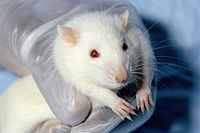
Photo from wikipedia
The purpose of this study was to conduct initial characterization of membrane vesicles isolated from human placenta by agitation of villous tissue (apical and basal) as well as vesicles obtained… Click to show full abstract
The purpose of this study was to conduct initial characterization of membrane vesicles isolated from human placenta by agitation of villous tissue (apical and basal) as well as vesicles obtained following dual perfusion of placental lobule. The morphology, physical and biological properties of the isolated vesicles were determined by electron microscopy, dynamic light scattering, and immunoblotting as well as nanoflow liquid chromatography-mass spectrometry proteomics analysis. CD-1 male mice were used to test the biocompatibility of the vesicles in vivo and assess the biodistribution of fluorescently labeled apical and perfusion vesicles. The vesicles obtained following placental perfusion and the apical vesicles had Z-average diameters of 199±23 nm and 246±24 nm, respectively, and demonstrated nanocarrier stability, low toxicity, and low immunogenicity. On the other hand, administration of basal vesicles resulted in animal demise with LD50 of 0.85 μgprotein/g. Both fluorescently labeled apical and perfusion vesicles were detected in the lungs, liver, kidneys, and spleen of CD-1 mice within 24 h of administration. However, there were differences in organ distribution of these vesicles over 24 hours time period. These data suggest that placental apical and perfusion vesicles have a potential for further development as biological vehicles for drug delivery.
Journal Title: Journal of biomedical nanotechnology
Year Published: 2022
Link to full text (if available)
Share on Social Media: Sign Up to like & get
recommendations!